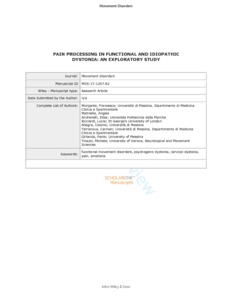Morgante, F; Matinella, A; Andrenelli, E; Ricciardi, L; Allegra, C; Terranova, C; Girlanda, P; Tinazzi, M
(2018)
Pain processing in functional and idiopathic dystonia: An exploratory study.
Mov Disord, 33 (8).
pp. 1340-1348.
ISSN 1531-8257
https://doi.org/10.1002/mds.27402
SGUL Authors: Morgante, Francesca Ricciardi, Lucia
![[img]](http://sgultest.da.ulcc.ac.uk/110651/1.hassmallThumbnailVersion/Morgante%20et%20al_Pain%20threshold%20in%20F-dys_%20270218.pdf)  Preview |
|
PDF
Accepted Version
Available under License ["licenses_description_publisher" not defined].
Download (750kB)
| Preview
|
Abstract
BACKGROUND: Pain is often experienced by patients with functional dystonia and idiopathic cervical dystonia and is likely to be determined by different neural mechanisms. OBJECTIVE: In this exploratory study, we tested the sensory-discriminative and cognitive-emotional component of pain in patients with functional and idiopathic dystonia. METHODS: Ten patients with idiopathic cervical dystonia, 12 patients with functional dystonia, and 16 age- and sex-matched healthy controls underwent psychophysical testing of tactile and pain thresholds and pain tolerance. We delivered electrical pulses of increasing intensity to the index finger of each hand and the halluces of each foot. Pain threshold and pain tolerance were respectively defined as the (1) intensity at which sensation changed from unpainful to faintly painful and (2) intensity at which painful sensation was intolerable. RESULTS: No differences were found between the three groups for tactile and pain thresholds assessed in hands and feet. Pain tolerance was significantly increased in all body regions only in functional dystonia. Patients with continuous functional dystonia had higher pain tolerance compared to subjects with paroxysmal functional dystonia and idiopathic cervical dystonia. There was no correlation between pain tolerance and pain scores, depression, anxiety, disease duration, and motor disability in both groups. CONCLUSIONS: Patients with functional dystonia have a dissociation between the sensory-discriminative and cognitive-emotional components of pain, as revealed by normal pain thresholds and increased pain tolerance. Abnormal connectivity between the motor and limbic systems might account for abnormal pain processing in functional dystonia. © 2018 International Parkinson and Movement Disorder Society.
| Item Type: |
Article
|
| Additional Information: |
This is the peer reviewed version of the following article: Morgante, F. , Matinella, A. , Andrenelli, E. , Ricciardi, L. , Allegra, C. , Terranova, C. , Girlanda, P. and Tinazzi, M. (2018), Pain processing in functional and idiopathic dystonia: An exploratory study. Mov Disord., 33: 1340-1348, which has been published in final form at https://doi.org/10.1002/mds.27402. This article may be used for non-commercial purposes in accordance with Wiley Terms and Conditions for Use of Self-Archived Versions. |
| Keywords: |
cervical dystonia, emotions, functional movement disorders, pain, psychogenic dystonia, functional movement disorders, psychogenic dystonia, cervical dystonia, pain, emotions, cervical dystonia, emotions, functional movement disorders, pain, psychogenic dystonia, 1103 Clinical Sciences, 1106 Human Movement And Sports Science, 1702 Cognitive Science, Neurology & Neurosurgery |
| SGUL Research Institute / Research Centre: |
Academic Structure > Molecular and Clinical Sciences Research Institute (MCS) |
| Journal or Publication Title: |
Mov Disord |
| ISSN: |
1531-8257 |
| Language: |
eng |
| Dates: |
| Date | Event |
|---|
| 19 September 2018 | Published | | 8 May 2018 | Published Online | | 5 March 2018 | Accepted |
|
| Publisher License: |
Publisher's own licence |
| PubMed ID: |
29737565 |
| Web of Science ID: |
WOS:000448866400021 |
 |
Go to PubMed abstract |
| URI: |
http://sgultest.da.ulcc.ac.uk/id/eprint/110651 |
| Publisher's version: |
https://doi.org/10.1002/mds.27402 |
Statistics
Item downloaded times since 13 Feb 2019.
Actions (login required)
 |
Edit Item |



